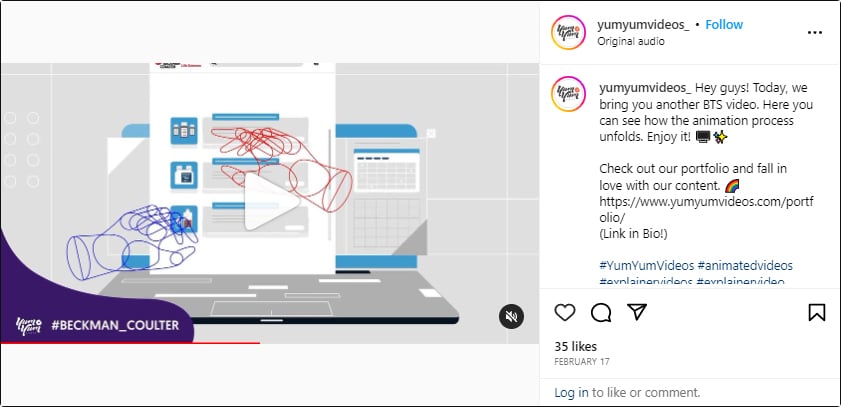Table of Contents
How to Master Your Video Content Marketing Strategy

The popularity of video content has increased enormously over the past few years, and that isn’t changing any time soon. So, whether you’re a small business or a large enterprise, video content marketing isn’t something you can afford to ignore.
But why is it so important to have a video content marketing strategy set in place? Well, that’s what this article is all about! In addition to explaining what video marketing is and why it’s crucial for your business, I’ll also discuss video distribution and how to measure the success of your strategy.
I don’t want to keep you waiting, so let’s jump right in!
Table of Contents
1. What Is Video Content Marketing?
Video content marketing is a subcategory of content marketing that focuses on consistently creating and sharing helpful, relevant, and engaging video content with your audience to create interest in your products or services.
The goal behind a video marketing strategy is to capture your viewers’ attention and get them hooked on your brand, ultimately gaining their trust and converting them into customers.
Video marketing can take many forms: social media videos, customer testimonials, explainer videos about your brand… The options are almost limitless! However, the specific goal you want to achieve, such as increasing engagement, promoting a product, educating your audience, and so on, will define the video types you have to produce.
2. Why Is Having a Video Content Marketing Strategy Crucial?
More and more brands are using video content as part of their digital marketing efforts, and it’s easy to see why: video has become immensely popular, and all the big social media platforms like Facebook or Instagram are pushing video above other content types. People simply love this type of content!
However, there are many other reasons to develop a video content marketing strategy of your own. Let me go over some of the most important ones:
2.1 Creating a Connection with Your Viewers
More often than not, marketing videos bridge the gap between brands and their audiences by telling a story through relatable characters and situations, leaving a lasting impression on their minds. Using video is key to letting your audience know you understand their struggles and can help solve them, as the combination of images is perfect to convey emotions and tell a story.
2.2 Reaching New Audiences
Since video content is highly shareable on social platforms, creating and distributing videos greatly increases your chances of reaching new targets effortlessly and boosting brand awareness. Think about it: when was the last time you discovered a new business through an infographic or a whitepaper rather than through a funny or informative video?
2.3 Helping Your Branding Efforts
Your business needs to stand out visually from the competition, and videos represent a great opportunity to enhance your brand identity. Something as simple as using your trademark colors and fonts in your video’s design elements is a simple yet effective way of increasing brand recall while also giving your pieces a feeling of cohesion. Also, don’t forget to add your logo at the end of your videos to drive the point home and further improve recognition!
2.4 Educating Current And Prospective Customers
When you provide your audience with useful and relevant content, you position your business as a helpful source of knowledge. However, as much as people like educational content, they typically prefer to get it through a short, engaging video instead of having to read a wall of text (and who can blame them!). So, why not give them what they want?
2.5 Encouraging Purchase Decisions
Video content such as customer testimonials or product demos is perfect for those prospects at the final stage of the Buyer’s Journey, since it allows you to actually show (rather than tell) why your business is better than the competition. You can talk about the benefits of choosing your brand as much as you want, but in the eyes of a customer, nothing beats seeing those benefits in action by themselves.
2.6 Aiding Your SEO Efforts
Google loves video content and will index relevant pieces at the very top of the results pages for many user queries. If you apply some key SEO best practices to your videos’ titles and metadata, you can increase your chances of landing on the first page of the SERPs organically.
2.7 Creating an Evergreen Asset
As long as your pieces aren’t trend-focused, video content can be recycled and reused many times. A single video can be posted on YouTube, embedded on your website, and uploaded as snippets on your social media pages. Additionally, “timeless” videos such as customer testimonials, FAQs, or product demos can be valuable and informative for new audience members no matter when they see them.
3. Best Types of Video Content Marketing for Your Strategy
There are quite a few different video types that can work wonders for your marketing efforts. Since I’ve already gone over some of them, like testimonials, I want to focus on others that I think can be immensely useful for your strategy:
3.1 Explainer Videos
These pieces are both easy to understand and super entertaining to watch. They typically feature animated characters (although there are some good live-action ones out there), and they’re used to explain to your audience what your brand is all about and why your product or service can help them.
3.2 How-To Videos
In the case of how-to videos, the goal is to give detailed step-by-step instructions about how to use or interact with your product or service. They’re great for solving any inconvenience your audience may encounter before it even happens! What’s more, how-to searches are very popular, so you’re bound to get quite the traffic boost with these pieces 😉.
3.3 Whiteboard Videos
Whiteboard videos are the go-to tool when you need to tackle complex topics and explain them in a way that your audience can easily understand. The use of a whiteboard mimics a teacher-student interaction, so it’s a great choice to deliver educational content and keep your viewers hooked right until the end.
4. How Do I Distribute My Video Content?
Once you’ve developed your video content marketing strategy, you need to focus on how to distribute your pieces effectively to get the best results. So, let’s break down the two types of distribution channels available, so you can choose the perfect one for your business:
4.1 Owned Distribution Channels
Owned distribution channels are those you get free access to and control, such as your website, social media pages, email lists, apps, and the like. They’re the main sources of information about your brand, so they can’t be ignored when it comes to distributing your video content marketing strategy.
What’s great about owned channels is that you can freely experiment with different video types and formats until you find what works for your brand and what doesn’t, before investing in paid distribution channels.
While YouTube and social media may seem like the obvious option to upload your video content to, I highly encourage you to include your pieces in email newsletters, your website, and blog posts as well. There’s no guarantee that all your audience members will be active on social platforms, so you may have to reach them through other means!
4.2 Paid Distribution Channels
While paid distribution isn’t essential, many businesses still choose this option for different reasons. One of the benefits of paid channels (such as social media ads or YouTube ads) is that they allow you to target a very specific demographic —you can choose the location, age, gender, and interests of the people you want to reach. This significantly increases the odds of your video content reaching the exact kind of audience you have in mind.
However, the key to effective paid advertising is to consistently measure its performance. You can invest thousands of dollars into a paid distribution channel, but it will be worthless if you don’t know whether your campaigns are actually working. Moreover, while this option might get you metrics to boost quickly, it usually becomes unsustainable in the long run due to the high investment required.
Personally, I advise you to increase your reach organically through owned channels first, and then dive into paid distribution.
5. Measuring The Success of Your Video Content Marketing Strategy
Before I say goodbye, I want to tackle how to measure the success of your video strategies. Here are some of the most relevant KPIs (Key Performance Indicators) you should take into account:
5.1 View count
This is the number of people who watched your video for a certain number of seconds. However, take into account that different platforms measure views differently. For example, a view on YouTube is 30 seconds, while a view on Facebook is around 5 seconds.
5.2 Impressions
These are the total number of times your video has been displayed on a user’s screen. If your video has a high number of impressions, but a low number of views, it may be time to optimize your strategy.
5.3 View-through rate
Also called “play rate,” this is the number of people who watched your video, divided by the number of total impressions. This is one of the most important metrics you should analyze since it indicates how relevant or appealing your video strategy really is for your audience.
5.4 Video completion
This is the number of people who watched your video fully, from beginning to end. It’s a more reliable metric than view count to really measure the success of your video content marketing strategy.
5.5 Completion rate
This is the number of people who watched your entire video, divided by the number of people who clicked on it. If you have a low completion rate, you might need to brainstorm some ideas to hook your viewers right from the start and keep them engaged for the whole video.
5.6 Click-through rate
Your CTR measures how many times your viewers clicked on your Call To Action (CTA), divided by the number of views. Even if you have a high completion rate, check your CTR regularly to know if your CTA’s design or copy needs to be readjusted.
6.7 Conversion rate
This is the number of times people carried out your desired action, divided by the number of people who clicked on your CTA. Check this metric regularly, so you can determine which video types are the best at achieving your goals.
6.8 Social media shares and comments
These are good indicators of how relevant and interesting your video content marketing strategy is for your audience. Additionally, since videos with many interactions are placed as suggestions on people’s feeds, if your video has a high number of shares and comments, it’ll reach more viewers organically.
Wrapping Up
Well, that’s all for now! I hope I’ve inspired you to launch a video content marketing strategy soon 😉.
No matter your industry or the size of your business, you simply can’t ignore video content any longer. Even a few pieces can have the power to take your brand to the next level!
So, now that you know the benefits of implementing a video strategy, where to distribute it, and how to measure its success, the only thing left to do is start brainstorming one of your very own. I’m sure it’ll be great!







